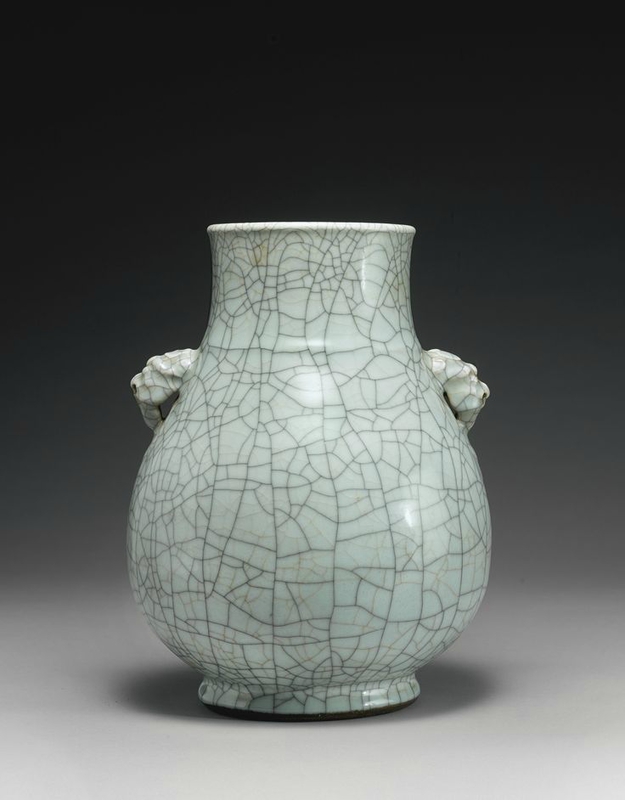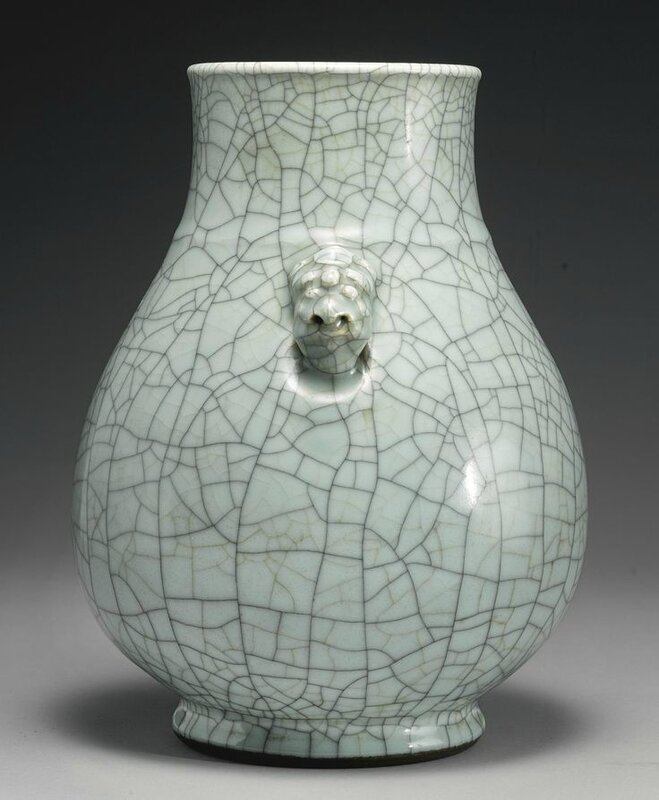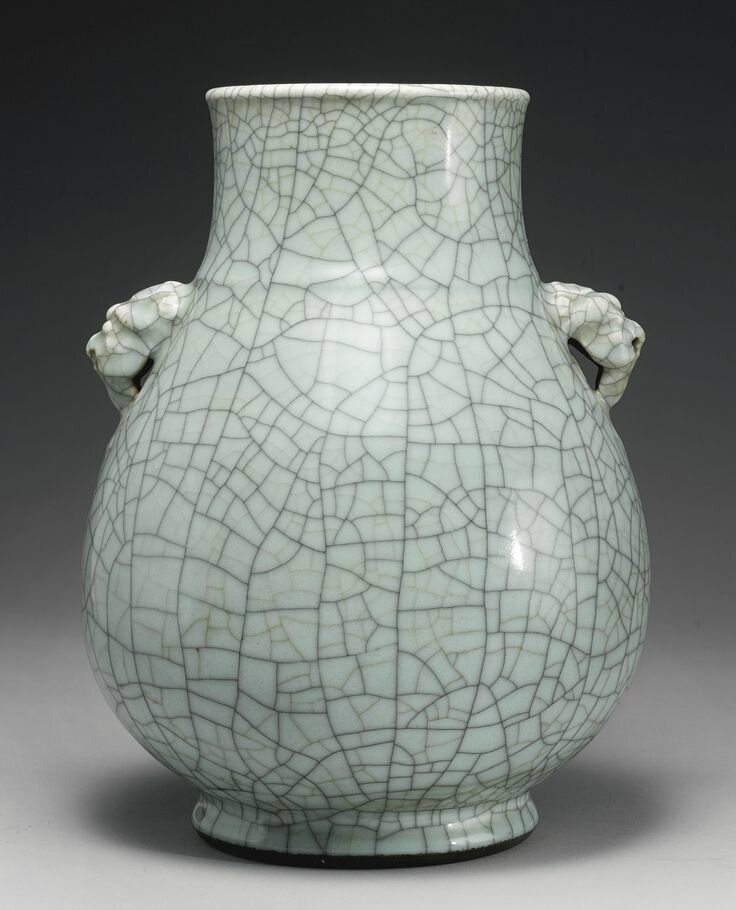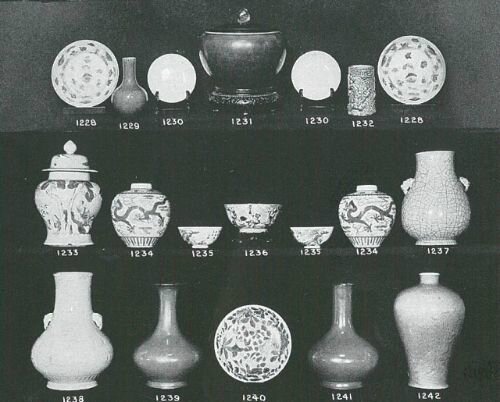A rare Guan-type vase, hu, Qianlong seal mark and period (1736-1795)
Lot 287. A rare Guan-type vase, hu, Qianlong seal mark and period (1736-1795). Height 11 3/4 in., 30 cm. Estimate 70,000 — 90,000 USD. Lot sold 87,500 USD. Photo Sotheby's.
of archaistic hu form, the ovoid body tapering to a waisted flared neck, set to either side with a lion-head-form loop handle at the shoulder, applied overall in a thick pale bluish-gray glaze suffused with a bold network of steel gray and pale gold crackles stopping at the unglazed footring dressed in a dark brown wash in imitation of Song dynasty guan ware, a six-character seal mark in underglaze blue.
Provenance: Yamanaka & Company, New York, 1943.
Henry Dourif (1881-1967) Huntington, West Virginia and thence by descent.
Exhibition: Yamanaka & Company, Collection of Chinese and Other Far Eastern Art, (in liquidation under the supervision of the Alien Property Custodian of the U.S), New York, 1943, cat. no. 1237.
Yamanaka & Company Catalogue, 1943
Note: The crisply molded lion-form loop handles on the present piece are striking and appear to be a unique feature varying from the usual shallow applied lion-mask handles with pendent rings or the rarer elephant-head loop handles. The bold feature is a charming 18th century innovation on a vase that in both form and glaze references two well-known early accomplishments of Chinese art: the iconic hu form derived from the great bronzes of the Shang dynasty and the rich crackled glaze of the famed Guan wares of the Southern Song dynasty. The official or Guan ware was produced for the court in the capital, Hangzhou in Zhejiang province. Laohudong in southern Hangzhou appears to have been the most important Guan kiln creating wares with an attractive crackled glaze, a version of which is seen on the present piece. The crackle was purposefully made utilizing refined technical skill to calibrate a cooling rate for the wares that would produce the different layers of fissures and allow them to be filled with two to three different colors. The present piece with its two tones references the jinsi tiexian (gold thread and iron wire).
Such a pointed allusion to the past served to both pay homage to the past while simultaneously noting the technical achievements of the present. Archaism enjoyed a major revival during the height of the Qing dynasty under the Yongzheng and Qianlong emperors. The combination of a precious glaze and ancient form suggests a deep appreciation and respect for the past, together with the want for its preservation.
Harry Dourif (1881-1967)
Henri Dourif, co-founder of Standard Ultramarine and Color Company in Huntington, West Virginia, was born in France on April 15, 1881. He graduated from École Centrale in 1904 with the degree of Ingénieur des Arts et Manufactures and then took military training at Nimes. In 1906 he began his industrial career as an engineer with Deschamps Frères, a French company that produced the ultramarine blue pigment. During World War I he was a pilot, promoted to Captain and later awarded the prestigious Croix de Guerre. After the war he returned to the United States and the Standard Ultramarine and Color Company where his talent and dedication helped expand the business earning it a strong international reputation and supplying its products all around the world.
Sotheby's. Important Chinese Works of Art New York, 17 march 2015, 02:00 PM

/https%3A%2F%2Fprofilepics.canalblog.com%2Fprofilepics%2F1%2F0%2F100183.jpg)
/https%3A%2F%2Fstorage.canalblog.com%2F03%2F02%2F119589%2F96711876_o.jpg)
/https%3A%2F%2Fstorage.canalblog.com%2F11%2F31%2F119589%2F94773502_o.jpg)
/https%3A%2F%2Fstorage.canalblog.com%2F20%2F83%2F119589%2F94772815_o.jpg)
/https%3A%2F%2Fstorage.canalblog.com%2F26%2F72%2F119589%2F75604929_o.jpg)
/https%3A%2F%2Fstorage.canalblog.com%2F59%2F60%2F119589%2F26458628_o.jpg)









/http%3A%2F%2Fstorage.canalblog.com%2F63%2F62%2F119589%2F129821675_o.jpg)
/http%3A%2F%2Fstorage.canalblog.com%2F43%2F82%2F119589%2F129801198_o.png)
/http%3A%2F%2Fstorage.canalblog.com%2F40%2F90%2F119589%2F129784381_o.jpg)
/http%3A%2F%2Fstorage.canalblog.com%2F20%2F04%2F119589%2F129784037_o.jpg)